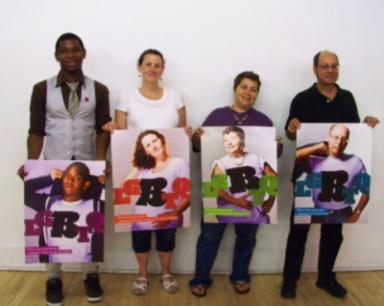“Put a group of bisexuals together in a room and the topic inevitability turns to our experience of biphobia and exclusion,” says Margaret Robinson, one of a team of researchers on queer health at the Centre for Addiction and Mental Health (CAMH).
Except on rare occasions.
Sept 15 at The 519 ballroom was one such instance. The room was full of bisexual folks, but there was no negative discussion. Rather, it was a celebration of a new visibility and inclusion campaign, This Is Our Community: Bisexual Anti-Stigma Campaign, funded by the Rainbow Health Network, Canadian Institutes of Health Research, and the Toronto Bisexuality Education Project.
“The campaign highlights four groups within the bi community that have been particularly marginalized: bisexual mothers, trans bisexuals, racialized bisexuals and bisexual youth,” Robinson says.
The campaign rolled out four posters to highlight these groups.
In one, a pregnant Danielle Sheppard poses in front of the words “This is my community . . . because I’m bi even if you think I look straight.”
Another, featuring Rupert Raj, states, “This is my community . . . because I’m bi and trans.”
Aintony Mortimor took part in the campaign even though he is not bisexual.
“I got involved because I have bisexual friends, and people who I have dated are bisexual, and behind all the . . . remarks and comments, these people are human and are not all the same like many people may think,” he says. “I wanted to help raise awareness in terms of bi stigma and help people realize how hard bisexual people have it, because of the double dose of oppression.”
Cheryl Dobinson, another member of the CAMH team, agrees, noting the harm caused by stereotypes.
“The poor health outcomes of bisexual people may be attributed to biphobia and the impacts of the myths and stereotypes about bisexual peoples,” she says. “That bisexuality is a phase or a transition; that bisexual people can’t make up their minds; that bisexuality isn’t a legitimate sexual identity; that bisexual people have a 50/50 attraction to men and women; that bisexual people are dishonest, promiscuous or cheat on their partners.”
A 2008 Statistics Canada report found that 25 percent of bisexual women and 11 percent of bisexual men reported a mood disorder such as depression. The numbers were lower for heterosexual and homosexual men and women.
Rupert Raj says the gay community has long ostracized him.
“I have been judged and criticized by both queer and trans people for my attraction to women, including trans women, and men, including trans men, and accused of not really being a man,” he says.
The campaign’s creative director, Sheila Sampath, says it will extend across Ontario and “far beyond Ontario’s borders.”
Sampath says she hopes the campaign will debunk stereotypes about bisexuality, take away the negative connotation surrounding the word bisexual and eventually eradicate biphobia.
The group gathered at The 519 is eager to get started.
“When is the day to celebrate bisexuality?” asked one participant during a trivia game.
“Every day!” shouted another, to loud cheers and whistles from the rest of the group.

 Why you can trust Xtra
Why you can trust Xtra


